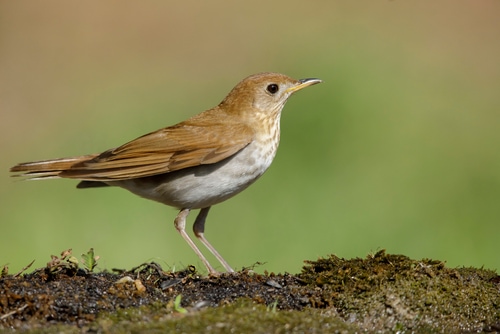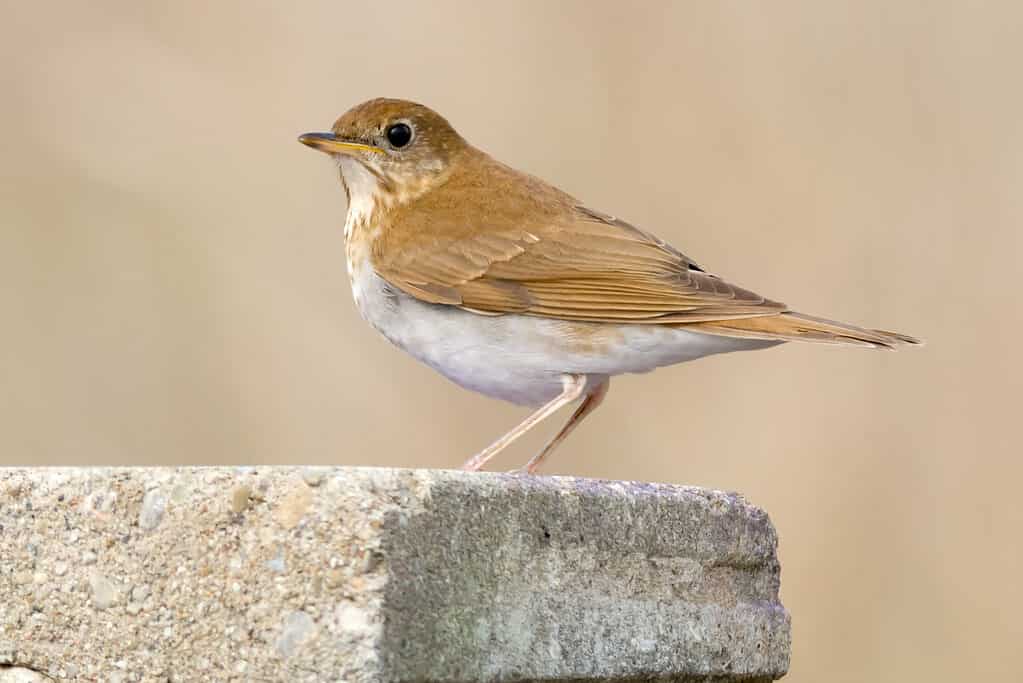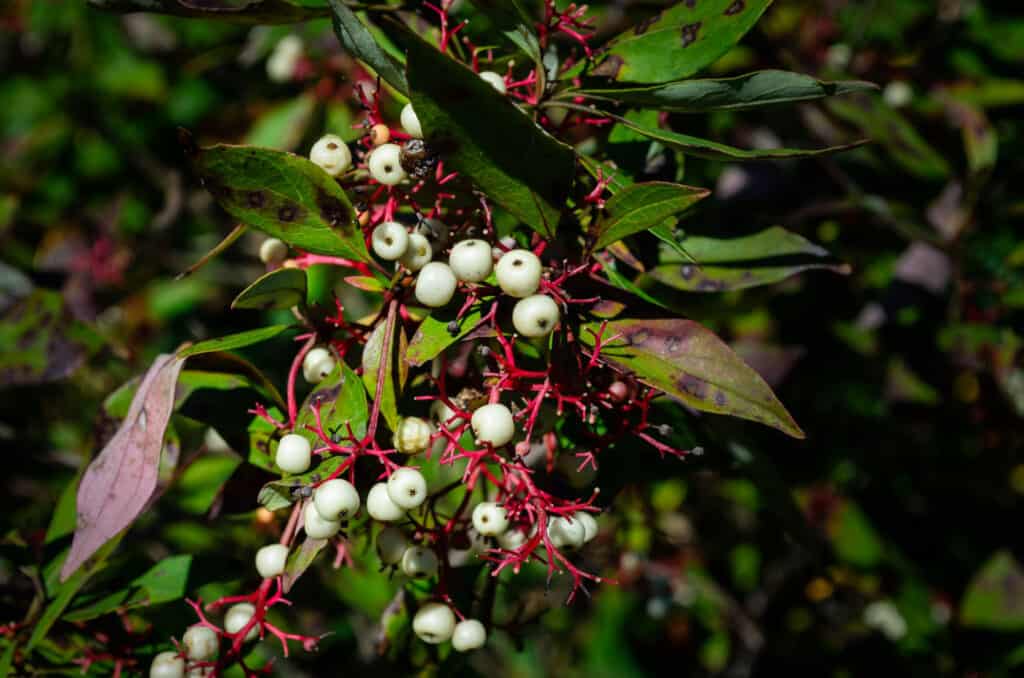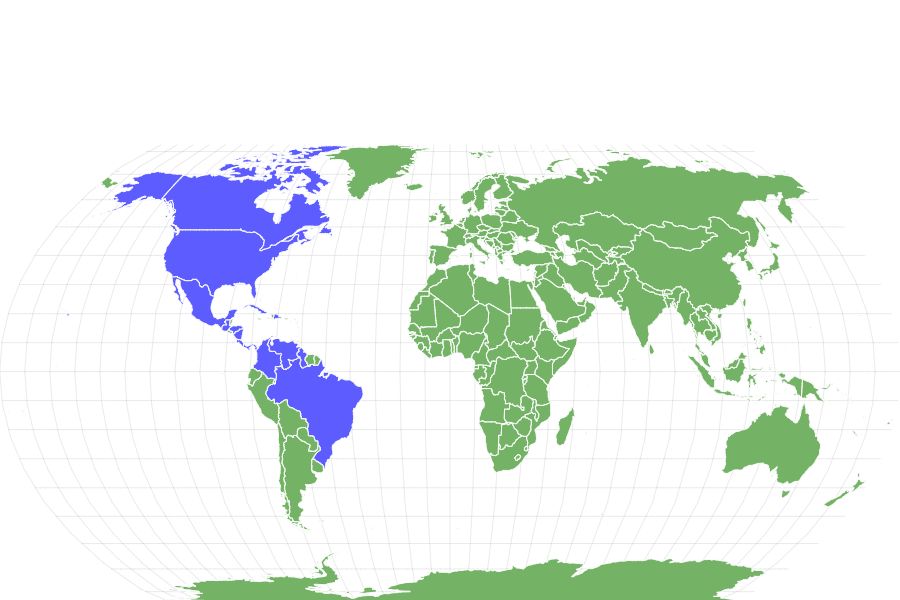The veery is named for its sharp "veer" call.
Advertisement
Veery Scientific Classification
- Kingdom
- Animalia
- Phylum
- Chordata
- Class
- Aves
- Order
- Passeriformes
- Family
- Turdidae
- Genus
- Catharus
- Scientific Name
- Catharus fuscescens
Read our Complete Guide to Classification of Animals.
Veery Conservation Status
Veery Facts
- Prey
- Insects and invertbrates
- Main Prey
- Insects
- Fun Fact
- The veery is named for its sharp "veer" call.
- Estimated Population Size
- 11 million
- Biggest Threat
- Loss of habitat
- Wingspan
- 11.0 to 11.4 inches
- Incubation Period
- 10 to 14 days
- Diet
- Omnivore
- Nesting Location
- On ground
- Migratory
- 1
Veery Summary
“The veery is named for its sharp ‘veer’ call.”
The veery thrush, also known just as the veery, is a small, migratory species of songbird. It is found in both North America and South America, though its exact location depends on the time of year. They are mainly insectivores. Occasionally, however, the veery may venture to eat vegetation, such as certain fruits.
Veery Amazing Facts
- Veeries can fly up to 160 miles in a single night during migration.
- A veery’s nest is susceptible to brood parasites, specifically the brown-headed cowbird.
- They are able to make transoceanic flights that other species of thrush may not be able to.
- They are most active in the early morning and at dusk.
Where to Find Veeries
The exact location where you can expect to spot these thrushes while bird-watching depends on the time of year. This focuses specifically on whether it is breeding season, nonbreeding season, or migration time.
During the breeding months, veeries are found in the northernmost extent of their range. This includes the northern states of the United States, as well as the southern regions of Canada. Veeries will breed in damp, dense forests, such as those typically located near rivers, streams, and similar freshwater sources. Their preferred trees of choice include:
- Alder
- Aspen
- Birch
- Cherry
- Fir
- Maple
- Oak
- Spruce
One of the most significant breeding areas for veeries is beaver wetlands. These are damp areas formed following the construction of a beaver dam. While this was previously a scarcely available habitat, it is becoming more and more accessible with the increases in the beaver population.
During migration, veeries can be found throughout the southeastern United States and the northeastern counties of South America. They winter in the central and southern regions of Brazil. In the midst of migration, you can find them lingering out forest edges, where they can often be seen on the ground foraging.

Veeries are often found foraging on the ground.
©Agami Photo Agency/Shutterstock.com
Veery Nests
Most often, breeding pairs will build their nests on the ground. If they choose to build their nest on an elevated surface, it is usually not higher than 5 feet. The female is responsible for building the nest while her mate guards both her and the territory from predators and rivals. It takes around 6 to 10 days for the female to build the nest.
To build the nest, the female begins by creating a platform. The nest itself is made of dead leaves, bark, and stems. After the female has used these materials to create the basic cup-shape of the nest, she will line it with rootlets and similar fine materials to create a soft, secure bedding for the eggs and future young hatchlings.
Veery Scientific Name
The scientific name for this species is Catharus fuscescens. They are in the Class Aves and the Order Passeriformes. They are in the Family Turdidae, which includes all species of passerine thrushes.
This species’ common name, veery, comes from the sharp “veer” call that it makes. Its genus, Catharus, comes from the Greek word katharos, which translates to mean “pure” and likely refers to its call as well.
Veery Size, Appearance, and Behavior
The veery is a medium-sized species of thrush. They have a plump body and round head, although their beak is thin and pointed. The average size of the adult veery ranges from 6.7 to 7.1 inches in length, and they weigh 1.0 to 1.9 ounces. The wingspan of a veery is 11.0 to 11.4 inches from wingtip to wingtip.
There are little to no differences between males and females of this species. The most common coloration is a brown-cinnamon plumage on their back and head, while their underside is pale. In most individuals, you will notice brown spotting along the chest and throat.
While there is no notable sexual dimorphism in the species, veeries do sport geographical or regional differences in appearance. Veeries that breed in two areas, Newfoundland and the westernmost region of their range, are often darker than their eastern and southern counterparts. These individuals will also have more noticeable spotting due to the darker coloration.
In the wild, veeries prefer to remain unseen in the forests they call home. In fact, it is easy to miss these small birds aside for their sharp, cascading call. They spend the majority of their time foraging along the ground and fallen vegetation for prey. Sometimes, they will choose to take flight and catch insects while doing so.
Males of this species can be aggressive, both to rivals and females. However, the aggression towards females will lessen before switching to courtship.

Veeries are medium-sized thrushes with rounded features.
©iStock.com/PaulReevesPhotography
Veery Migration Pattern and Timing
There are no significant year-round populations of veery. As a result, nearly every population will migrate, and they will do so around the same time and along similar routes.
Most often, individuals migrate from their breeding grounds through eastern North America and South America in order to winter in Brazil. At the end of winter, they will make a similar trek to return north.
Unlike many thrushes, thanks to their strong wings and optimized energy consumption, veeries can migrate along transoceanic routes.
Veery Diet
These birds have a diverse diet made up of both animal and plant components. They forage both on the ground and in the air, eating insects, amphibians, and wild fruits and berries. The exact percentage of their diet made up by each depends on whether or not it is breeding season. During the breeding season, animal matter is a larger part of the veery’s diet; during the rest of the year, plants.
What Do Veeries Eat?
Some of the animals that make up this species’ diet include:
- Beetles
- Ants
- Wasps
- Caterpillars
- Grasshoppers
- Flies
- Bugs
- Frogs
- Salamanders
Some of the plants that make up the veery’s diet include:
- Juneberries
- Honeysuckle
- Strawberries
- Blackberries
- Wild cherries
- Sumac
- Dogwood fruits
- Blueberries
- Wild grapes
- Elderberries

Sumac is a common plant part of this species’ diet.
©G_r_B/Shutterstock.com
Veery Predators and Threats
One of the biggest threats to the veery population is deforestation. These birds rely on specific habitats, habitats that are rapidly being developed and transformed into agricultural fields or human homes. Higher populations of deer and other herbivores that destroy dense woodlands also play a role in this loss of habitat.
Another threat towards veeries is brood parasites, such as the brown-headed cowbird. These take essential nutrients away from veery hatchlings, often resulting in a failure to thrive.
Lastly, there are also other natural threats, including predators.
What Eats Veeries?
Veeries, both adult and young, have several predators. Some of the animals that eat veeries include:
- Hawks
- Snakes
- Mice
- Feral and domesticated cats
- Owls
Veery Reproduction, Babies, and Lifespan
Veeries have one to two broods each year, with each brood containing anywhere from one to five eggs. These eggs are small, usually averaging around 1 inch or less in length, and are greenish-blue in color. The female will incubate her eggs for a period of 10 to 14 days before they hatch. When these young birds hatch, their eyes are closed, and they lack a significant amount of down. They will remain in the nest for 10 to 12 days.
They live to be up to 10 years old on average, although the oldest individual was at least 13 years old.
Veery Population
As of recent research and studies, there is an estimated global breeding population of 11 million veeries. They have maintained a somewhat consistent population at a glance, although a more in-depth look at the population in recent decades will show a slow decline. This decline is around 0.6 percent per year, for a total of 28 percent decline from 1966 to 2019. They are considered a species of least concern.
View all 25 animals that start with VVeery FAQs (Frequently Asked Questions)
Do veeries migrate?
Yes, they migrate north for breeding and south for winter.
How many eggs does the veery lay?
Between one and five eggs per brood.
What is the veery's wingspan?
The wingspan of a veery is 11.0 to 11.4 inches.
When do veeries leave the nest?
Hatchlings will leave the nest after 10 to 12 days.
Thank you for reading! Have some feedback for us? Contact the AZ Animals editorial team.
Sources
- , Available here: https://www.pwrc.usgs.gov/bbs/about/


















